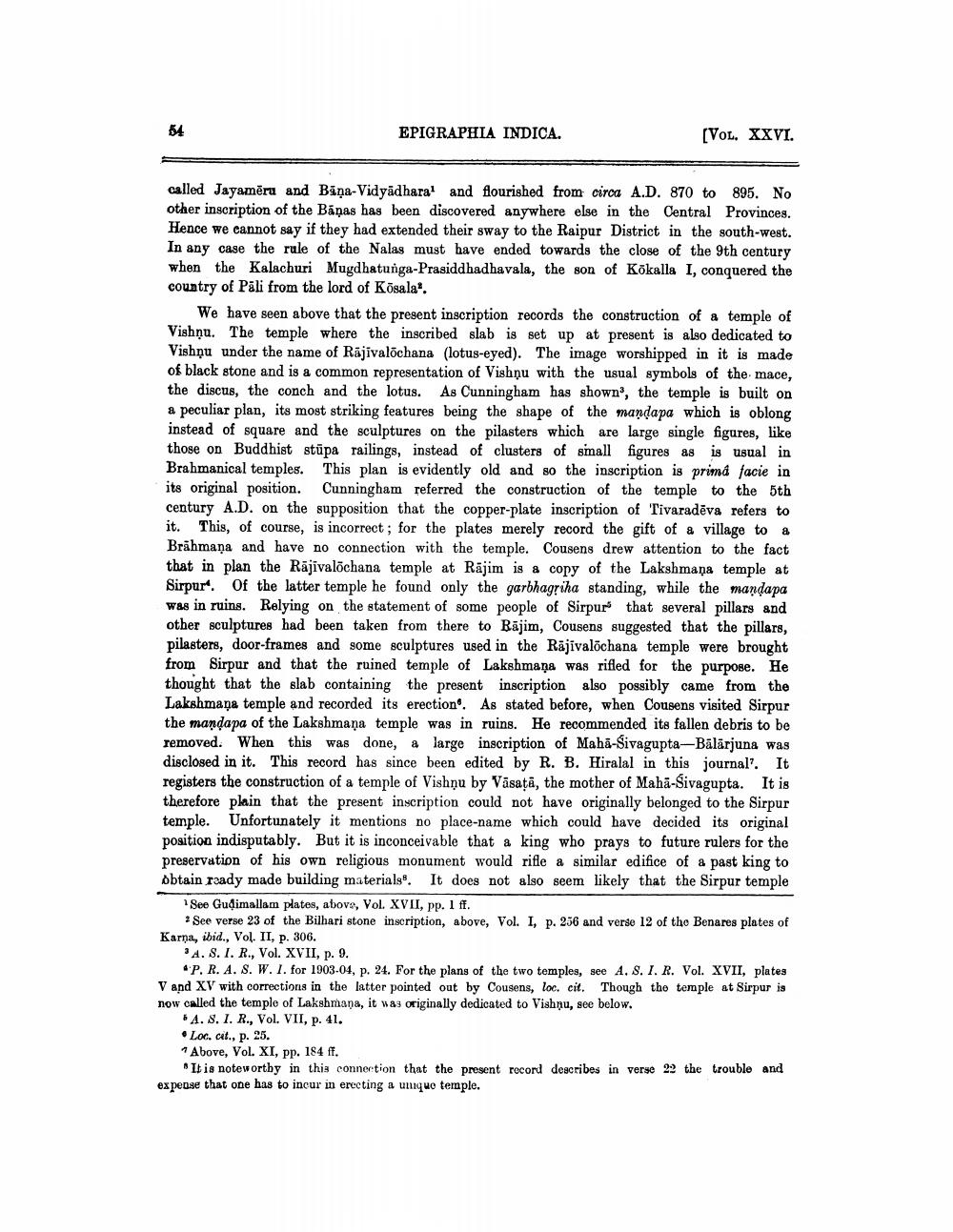________________
54
EPIGRAPHIA INDICA.
[Vol. XXVI.
called Jayamēru and Biņa-Vidyadharal and flourished from circa A.D. 870 to 895. No other inscription of the Banas has been discovered anywhere else in the Central Provinces. Hence we cannot say if they had extended their sway to the Raipur District in the south-west. In any case the rule of the Nalas must have ended towards the close of the 9th century when the Kalachuri Mugdhatunga-Prasiddhadhavala, the son of Kökalla I, conquered the country of Páli from the lord of Kösala.
We have seen above that the present inscription records the construction of a temple of Vishnu. The temple where the inscribed slab is set up at present is also dedicated to Vishņu under the name of Rajivalochana (lotus-eyed). The image worshipped in it is made of black stone and is a common representation of Vishņu with the usual symbols of the mace, the discus, the conch and the lotus. As Cunningham has shown', the temple is built on a peculiar plan, its most striking features being the shape of the mandapa which is oblong instead of square and the sculptures on the pilasters which are large single figures, like those on Buddhist stūpa railings, instead of clusters of sinall figures as is usual in Brahmanical temples. This plan is evidently old and so the inscription is prima facie in its original position. Cunningham referred the construction of the temple to the 5th century A.D. on the supposition that the copper-plate inscription of Tivaradēva refers to it. This, of course, is incorrect; for the plates merely record the gift of a village to a Brāhmana and have no connection with the temple. Cousens drew attention to the fact that in plan the Rājīvalochana temple at Rājim is a copy of the Lakshmaņa temple at Sirpur of the latter temple he found only the garbhagriha standing, while the mandapa was in ruins. Relying on the statement of some people of Sirpur that several pillars and other sculptures had been taken from there to Bājim, Cousens suggested that the pillars, pilasters, door-frames and some sculptures used in the Räjivalochana temple were brought from Sirpur and that the ruined temple of Lakshmana was rifled for the purpose. He thought that the slab containing the present inscription also possibly came from the Lakshmana temple and recorded its erection. As stated before, when Cousens visited Sirpur the mandapa of the Lakshmana temple was in ruins. He recommended its fallen debris to be removed. When this was done, a large inscription of Maha-Sivagupta-Bälärjuna was disclosed in it. This record has since been edited by R. B. Hiralal in this journal'. It registers the construction of a temple of Vishņu by Väsatā, the mother of Mahā-Sivagupta. It is therefore plain that the present inscription could not have originally belonged to the Sirpur temple. Unfortunately it mentions no place-name which could have decided its original position indisputably. But it is inconceivable that a king who prays to future rulers for the preservation of his own religious monument would rifle a similar edifice of a past king to obtain rady made building materials. It does not also seem likely that the Sirpur temple
See Gudimallam plates, above, Vol. XVII, pp. 1 ff.
* See verse 23 of the Bilhari stone inscription, above, Vol. I, p. 256 and verse 12 of the Benares plates of Karna, ibid., Vol. II, p. 306.
A.S. I. R., Vol. XVII, p. 9.
4 P. R.A.S. W. 1. for 1903.04, p. 24. For the plans of the two temples, see A. S. I. R. Vol. XVII, plates V and XV with corrections in the latter pointed out by Cousens, loc. cit. Though the temple at Sirpur is now called the temple of Lakshmana, it was originally dedicated to Vishnu, see below.
64.8. 1. R., Vol. VII, p. 41. • Loc. cit., p. 25. 1 Above, Vol. XI, pp. 184 ff.
It is noteworthy in this connection that the present record describes in verse 22 the trouble and expense that one has to incur in erecting a unique temple.




